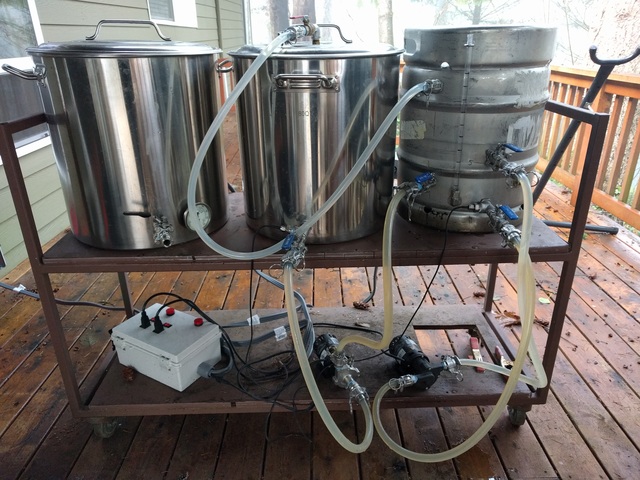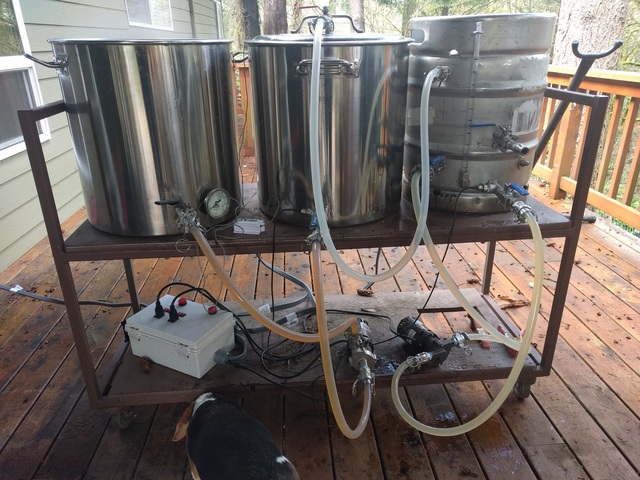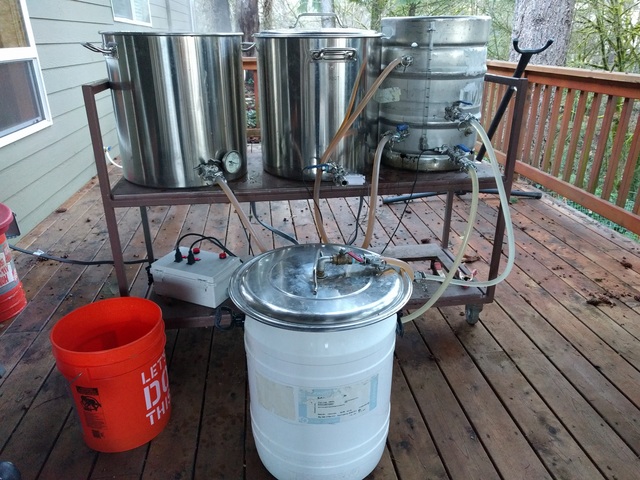A Typical Brewday
Fri December 30 2016 by Christopher AedoWhile writing about my electric brewing system I thought it would be helpful to outline what a typical brew day looks like with that setup. Since that post was already getting too long I decided to put this in it's own relatively small post.
The FIRST step is to figure out what I'm going to brew. Since I've moved up to 10gal batches and have the all electric system, I'm brewing more than I can reasonably drink. I guess it turns out I like making beer even more than I like drinking it. That means even when I've got four kegs on tap, I'm still thinking about what to brew next. I keep all my recipes on Brewtoad, so when I finally have room for another batch of beer I pick one of my favorite recipes and then go shopping. A few days before I plan to brew, I visit my local homebrew shop, Above The Rest to pick up the necessary ingredients so on brew day I've got everything I'm going to need.
On brew day (or the night before) I go back to the recipe on BrewToad and use the mash water calculator, choosing the mash profile for "Single Infusion, Sparge Rinse (BIAB)". Even though I'm not doing a brew-in-a-bag brew, the water calculation works out really well for my setup. I fill the HLT to the top measurement mark and then transfer the right amount for the strike water into the mash tun. Then I top the HLT back up. (If I want to get an early start on my brewing, I'll do this the night before). Once the water levels are right I set one pump to circulate the water in the HLT, and the other pump to circulate the water from the mash, through the coil, and back to the top of the mash tun.
When the pumps are running, I go to the CraftBeerPi URL on the RaspberryPi and set the HLT to hold at 140. It usually takes an hour or so to hit this temp so I've got plenty of time to go do other stuff without needing to watch the system. The mash tun lags behind by around five minutes, so I wait for the mash to stabilize at 140 before mashing in.

Next I shut off the mash pump and start to stir in my grains. I've got a big mash paddle and go relatively slow to make sure they're thoroughly wetted and there are no dough balls. Once all the grains are in I stir for another minute or two just for good measure. Then I make sure the mash return/sparge valve is open all the way and I turn on the mash pump. If I were less lazy I would vorlauf first, but the pump seems to do a really good job of it. When it's running clear, I close the valve down so it's moving slower and not spraying the mash too much. I know I run the risk of hot-side aeration with this but I really haven't noticed any flavor impact (then again I haven't gone through the BJCP yet so maybe there's some off flavors slipping in that I don't notice?)
Once the mash is recirculating through the coil in the HLT, I set the target temp to 151 (or higher if the style/recipe calls for it). It usually takes 20 minutes or so for the mash to hit 151, during which time I keep a close eye on it to make sure it's still circulating nicely and not stuck or anything.
When I reach the target temp I start a timer for 70 minutes, and go do other stuff. When the timer goes off I set the HLT temp to 173 and reset the timer for 20 minutes. This starts a slow-ish ramp up to mash out temp while the grain is still recirculating so the grain bed will reach mash out temp and the sparge water will be ready as well. (CraftBeerPi does have the functionality for setting multiple steps to automate a step-mash but I haven't gotten that to work right, and since the only step is to mash out I haven't tried to figure out what I'm doing wrong.)
Now I shut down both pumps and change the connections. The mash-out goes to the inlet on one pump with the outlet going to the boil kettle. The other pump was recirculating the water in the HLT, so I move the output of that pump to the inlet on the coil. The outlet of the coil still goes to the lid of the mash tun as it was doing while recirculating the mash.

When the connections are ready I turn the pumps back on and start pumping out the mash tun into the boil kettle while fly-sparging with the water from the HLT. I watch to make sure I transfer the right amount for the sparge and shut that pump off (and close the valves) when complete. Meanwhile the mash is still transferring slowly into the boil kettle. As soon as the heating element in the boil kettle is completely submerged, I turn on that element to get the wort up to boil.
When the mash is drained I turn off that pump and close the valves. At this point I keep a close eye on the boil kettle to watch for boil overs. Generally I just shut off the heating element when the hot break begins (and sometimes skim off some of the foam to help it along). Depending on the grain bill I sometimes have to cycle the heating element for a while until the foaming stops. Then I put in my bittering hops and start the timer for other additions.
While the brew is boiling, I remove the spent grains from the mash tun and then clean it out. When the brew is getting near the end I empty any remaining hot water from the HLT and pack it full of ice and cold water. I also make sure my fermenter is sanitized and ready to go.
When the brew is complete, I shut off the heating element and connect the boil kettle to the inlet of the mash pump. The outlet then goes to the coil, and the output of the coil goes to the lid I use for sparging (which has this fly sparge attachment from Northern Brewer in it.) Pumping the wort slowly through the coil in the HLT that's filled with ice water has worked out great for chilling the wort quickly, and the fly sparge fitting oxygenates the wort nicely.

After the wort has transferred to the fermenter, it's time to clean. At this point the mash tun and HLT are already clean, but the inside of the coil and the boil kettle both need to attention. I first rinse out most of the trub from the boil kettle with a hose. Then I transfer four gallons of the chiller water from the HLT into the kettle and raise the temp to 140. Recirculating that hot water through the coil, I dump in 4oz of "powdered beer wash" aka PBW. This solution recirculates for 30 minutes, with the HLT holding the temp steady. When the time is almost up I use a brush to make sure the heating element is clean and free of debris. Then I pump out the PBW solution (and dump whatever can't be pumped out of the boil kettle.) Then I transfer the remaining water from the HLT into the boil kettle and recirculate that for another 30 minutes. When that's done I pump it all out and I'm ready to brew again!
I haven't watched the time too closely on these brew days to be honest because I have so much extra time during the process to do other stuff. I haven't had any issues with temperature overshoots during the mash, and once things are running I can walk away until the next step. It's pretty convenient to check in on things on my phone in fact! BUT it also means I can't say for sure that this is a 5 hour brew day, or more (or less). Regardless, it's been pretty awesome for consistency and convenience. Switching to all electric is a decision I'm really happy with, would definitely recommend it.